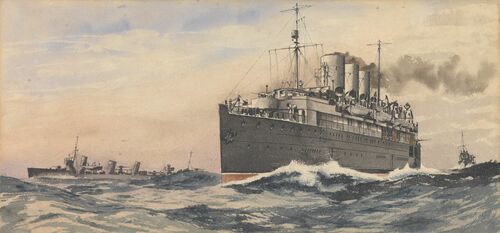Auction: 23113 - Orders, Decorations and Medals - e-Auction
Lot: 428
Four: Chief Petty Officer Telegraphist F. G. Plummer, Royal Navy, who saw destroyer service with Mohawk, Staunch and Jed in the Mediterranean
Later serving in the Baltic with Princess Margaret, helping to evacuate Riga as the city fell to the White Russian Forces and finally seeing Home Service during the Second World War
1914-15 Star (J.10107, F. G. Plummer, L. Tel., R.N.); British War and Victory Medals (J.10107 F. G Plummer. P.O.Tel. R.N.); Royal Navy L.S. & G.C., G.V.R. (J.10107 F. G. Plummer. C.P.O. Tel. H.M.S. Colombine.), mounted as worn, pitting, worn overall, polished, nearly very fine (4)
Frederick George Plummer was born at Hastings, Sussex on 6 May 1894, the son of Frederick and Ann Plummer of 1 Swan Lane, Hastings and joined the Royal Navy on 4 October 1910 as Boy Class II. Seeing service afloat for the first time aboard the battleship Dreadnought he reached his majority with her on 6 May 1912, being appointed Ordinary Telegrapher.
The Great War
Serving largely ashore prior to the outbreak of the Great War he was posted to the Destroyer Mohawk as Leading Telegraphist on 26 November 1914. Part of the Dover Patrol, this Tribal-class destroyer had an eventful career, narrowly avoiding being sunk on 1 June 1915 when she struck a mine laid by SM U11. Five of her crew were killed and the deck was awash by the time she made port, but fortunately Plummer survived.
Going ashore in July he was posted to the Acorn-class Staunch on 1 August 1915 just a few months before her posting to the Fifth Destroyer Flotilla in the Mediterranean. Here they joined the British fleet engaged in the evacuation of the Gallipoli Peninsula where it was becoming increasingly difficult to get men off the beaches. Staunch succeeded in carrying off a large number of men of the Worcestershire Regiment on 9 January 1916, one of the last evacuation runs made.
Removing to the destroyer Jed on 11 October 1916, Plummer continued to serve in the Mediterranean before removing to Ark Royal on 29 April 1917. This early seaplane carrier was stationed in the Aegean Sea at the time, with her aircraft supporting the Macedonian Front. It was here that Plummer was promoted Petty Officer Telegraphist on 1 July 1917, later leaving the vessel on 18 June 1918. He remained in the area with several ships, first starting with the repair ship Reliance and later Peony, which served as a partner to Ark Royal flying anti-submarine patrols in the Aegean.
Operation Red Trek
Leaving Peony after the war Plummer joined the minelayer Queen Margaret on 10 August 1919 after her return from the Baltic, where she had been acting as a troop transport. Queen Margaret was slated to return to the Baltic after her refit to perform her original role of minelayer, which occurred not long after Plummer joined her. Joining to the 20th Destroyer Flotilla, she was to lay mines at the British naval base of Reval.
After another brief refit she was back in the Baltic and in on the action during the Siege of Riga. The West Russian Volunteer Army, a German-supported but ostensibly White Russian force, attacked Riga on 8 October 1919. Queen Margaret was docked in the city at the time and as fighting grew fiercer she began to take on refugees, leaving the city on 12 October with many aboard including members of the British Mission.
Interwar and a return to Service
Plummer left Princess Margaret on 20 June 1920 and saw service with Queen Elizabeth, P59 and Dublin, being promoted Chief Petty Officer Telegraphist while ashore at Victory I on 1 November 1925. He was to serve for nearly another decade, notably with the destroyer Wallace, battleship Royal Sovereign and even H.M.S. Hood. He was pensioned on 5 May 1934.
This was not to be the end of his time with the Royal Navy however, as despite his age Plummer returned to service on 17 January 1940. Serving ashore at Victory I with his old rank of Chief Petty Officer Telegraphist it was soon clear that his health was not up to the task. Despite this he managed nearly a year of service, being invalided on 11 December 1940.
Plummer died at Edinburgh, Scotland in 1960, the same year as his wife Florence and was survived by his daughter Ivy; sold together with copied research comprising census data and service records.
Subject to 20% VAT on Buyer’s Premium. For more information please view Terms and Conditions for Buyers.
Sold for
£130
Starting price
£60







